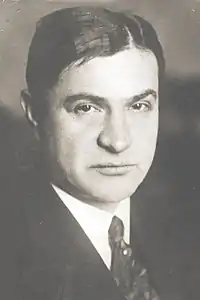Bronisław Wilhelm Pieracki | |
|---|---|
 Bronisław Pieracki | |
| Minister of Interior of the Republic of Poland | |
| In office 23 June 1931 – 15 June 1934 | |
| Preceded by | Felicjan Sławoj Składkowski |
| Succeeded by | Leon Kozłowski |
| Personal details | |
| Born | 28 May 1895 Gorlice, Austria-Hungary |
| Died | 15 June 1934 (aged 39) Warsaw, Poland |
| Resting place | Cemetery in Nowy Sącz |
| Nationality | Polish |
| Political party | Nonpartisan Bloc for Cooperation with the Government |
| Occupation | Politician, military officer |
| Military service | |
| Branch/service | Polish Army |
| Battles/wars | Polish-Ukrainian War |
Bronisław Wilhelm Pieracki (28 May 1895 – 15 June 1934) was a Polish military officer and politician.
Life
As a member of the Polish Legions in World War I, Pieracki took part in the Polish-Ukrainian War (1918–1919). He later supported Józef Piłsudski's May 1926 Coup.
In 1928 Pieracki was a deputy in the Polish Sejm from the Nonpartisan Bloc for Cooperation with the Government, and afterward deputy Chief of Staff .
He was minister of internal affairs from 27 May 1931[1] until his 1934 assassination, and was posthumously awarded Poland's highest civilian and military decoration, the Order of the White Eagle.
Assassination
On 15 June 1934, Pieracki was assassinated by a member of the Organization of Ukrainian Nationalists. His death gave Poland's Sanation government a justification to create, two days after the assassination, the Bereza Kartuska Prison. The prison's first detainees were almost entirely the leadership of the Polish nationalist far-right National Radical Camp (the ONR), arrested on 6–7 July 1934.[2]
Sentenced to death in the Pieracki assassination were Stepan Bandera, Mykola Lebed, and Yaroslav Karpynets. Their sentences were commuted to life imprisonment, and both managed to escape during the invasion of Poland.[3]
Honours and awards
- Order of White Eagle
- Order of Polonia Restituta
- Silver Cross of the Virtuti Militari
- Cross of Valour - four times
- Gold Cross of Merit
- Order of the Cross of the Eagle Class I (Estonia, 1934)
See also
References
- ↑ Robin L. Bidwell, "Bidwell's Guide to Government Ministers Vol.1, The major powers and western Europe, 1900-1971", Frank Cass & Co Ltd, 1973, ISBN 0-7146-2977-4, p. 191.
- ↑ Rudnicki, Szymon (1977). "Rozbicie ruchu młodzieżowego "Obozu Narodowego"". Dzieje Najnowsze. 9 (1): 23–46 (43).
- ↑ Breitman, Richard; Norman J.W. Goda (2010). Hitler's Shadow: Nazi War Criminals, US Intelligence, and the Cold War (PDF). National Archives. p. 73. Retrieved 2010-12-12.
Further reading
- (in Polish) Andrzej Misiuk Białym żelazem, Gazeta Wyborcza, 12/07/1994.